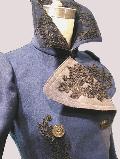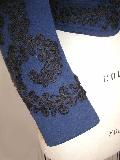The deep royal blue woman's jacket, c.1900, is made from heavy wool and French broadcloth, a combination of weaving and felting, generally referred to as Melton. It is lined in bright pink cotton and trimmed with passementerie. The bottom edge has a petal shape.
Construction Details
Circa 1900, this double-breasted outer coat is made of Melton wool that has been dyed into a deep royal blue. The lining is a cotton, satin weave dyed bright pink. The inner piping is made out of this pink cotton as well. The two pocket linings are made from black silk. There is an inner layer of heavy canvas that is sandwiched between the collar and facing to produce the high stand at the back of the neck and to support the large lapels at front. The outside of the coat is decorated with black cotton passementerie braid at the front lapels, around the collar edge, down center front, around the hem to the back. Center back has a large motif as well as do the lower edges of sleeve hems. There are two hand finished button holes 1 1/4" wide with a set of four mother of pearl buttons (one is missing) that close the double breast. Six comparable sized hooks and eyes are used at the center front of the collar to help keep the coat closed when fully buttoned up.
Popular during the late Victorian period, high collars were common for not only daily clothing, but also appeared in outer garments as well. The outer circular collar is comprised of four trumpeted gore panels that stand 6" tall each. Sandwiched between the under collar and outer collar is the canvas interfacing that helps the collar to stand and roll back slightly. The under collar is self fabric that have the same four trumpeted gore panels. The collar's edge is unfinished and the two layers are top stitched together. The neck edge of the collar is piped with the pink cotton satin for an inside finish. Black trim is applied around the circumference of the top collar only through the top layer. Two sets of hooks and eyes are used to close coat at center front neck to maintain the high neck and full coverage of the chest.
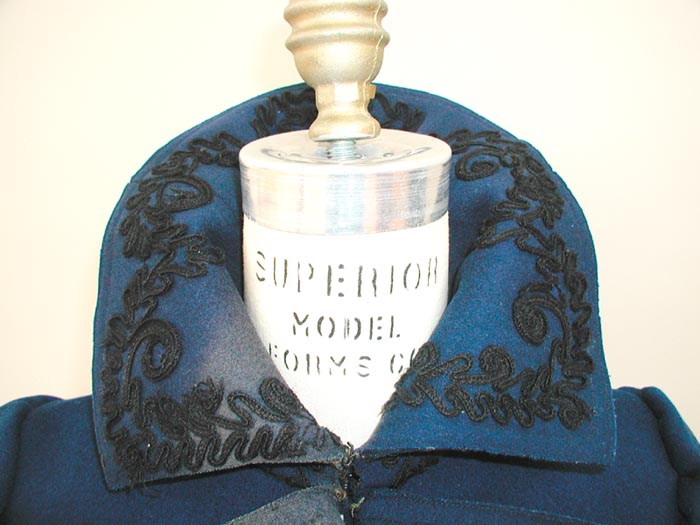
According to the Sears, Roebuck and Co.'s Fall 1900 Consumers Guide, popular outer coat shapes appear to be double breasted. The front of the coat is an asymmetrical (right over left) double breast. The lapel is a 6" wide peak lapel that turns back at the roll line. The right side of the coat has a dart at center front neck that is angled down toward the bust point. There is a hand finished buttonhole 10" down from the peak point of the lapel. The second button hole is 5" below first button position. The button holes are small horizontal, keyholes that are 1 1/4" wide, and are 3/8" away from center front. The button holes are finished by hand using tan gimp and black cotton button thread. The third position is a mother of pearl button that is 6 1/2" directly across from center front. The fourth position is another mother of pearl button which is 5" down from first button and 4 1/4" across from center front.
The lower front hem of the coat is shaped into a petal point that leads in to a side front dart that is 6" long and is angled toward the bust point to help shape the waist. There is a welt pocket placed 1 1/4" away from the waist dart and 2 1/4" up from the shaped hem. The pocket opening measures only 2 1/4" wide and is faced with self fabric and has black silk lining. The welt pocket has its raw edges double top stitched on both top and bottom of the opening. Although the pocket was not inherently functional for carrying a great deal, it is reminiscent of the late-Victorian attention to detail that was so prominent in women's clothing. The side front of the hem is a rounded petal shape which curves to the side seam. Black trim is applied to the top over lap breast of the coat from below the button hole, down to the petal point and back up along the waist dart to 1" past the first button position. Black trim is also applied to the lapel facing, filling the lapel width to within 1" from the edge. The shoulder seams begin at the neck and angle down to the back of the coat creating a dropped shoulder line.
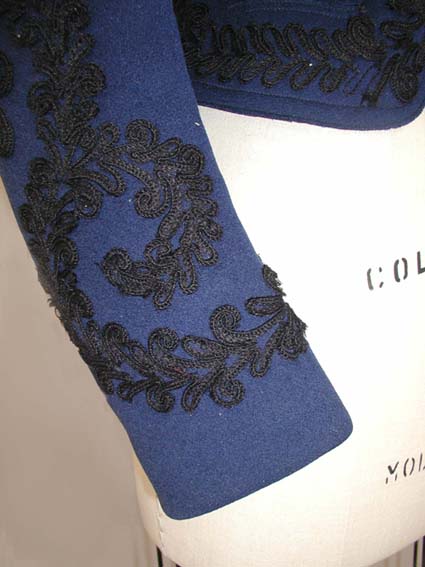
The center back panel is cut on the fold; other pieces in the back have a fiddle back shape. These very curved seams help to accentuate and minimize the waist line. The width of the panel is 11 1/2" from shoulder point to shoulder point tapering down to 2 3/4" at the waist, then widening out again to 3 1/2" to form a petal point hem. Black trim is arranged into a large, curved motif which fills the upper portion of the panel and trails down to the hem. The side back panels are 2 1/4" wide at the armscye, and curve to follow the center back panel. They taper down to 2" at the waist, then widen out again to 3" to create a rounded petal hem. Black trim is applied continuously from front to back crossing all seam lines and following the petal shape hem.
The sleeve is made in two pieces of a top and an under sleeve, to create a very fitted and shapely arm. The top sleeve panel is 1" away from the side back seam. The fullness is eased into 15" from top seam line to top seam line. The width of upper sleeve is 10" at the bicep and tapers down to 7" at wrist from seam line to seam line. Black trim is applied 1" above the sleeve hem and trellises up to elbow point. The under sleeve panel is 5" wide at the armscye and tapers down to 3 3/4" at the hem. Black trim is applied 1" above sleeve hem and is only 2 1/2" wide. It does not trellis up the way the top sleeve trim does. The hem of the sleeve is self-faced and the sleeve lining is slip stitched 1" above the hem edge to encase raw edges.
The full lining of the coat is made of seven panels and mirrors the seam lines of the outer coat. The hem is turned and slipped stitched 3/4" above the finished hem edge. The sleeve lining is also a two piece sleeve and is slipped stitched to the armscye and hem.
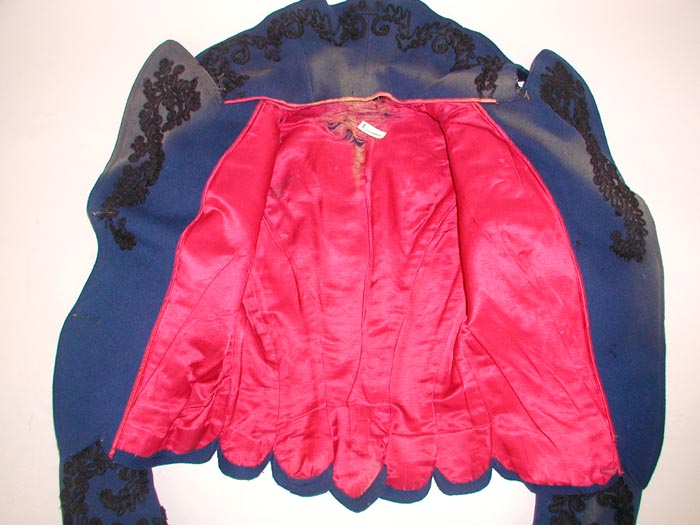
Summary
The coat in its entirety is a fine example of early twentieth century style. The large, high standing collar gives the wearer her modesty as well as calls attention to the tailored detail of the shaped construction. The over abundance of black trim is applied like icing and can been seen from any angle. The curved and flared petal hem helps to emphasize the smallness of the waist by giving the appearance of larger hips. And the slim, fitted sleeve slenderizes the arm and gives height to the shoulder. It appears that this style of coat would have been a carry over from late 19th century fashion. In Janet Arnold's book, Patterns of Fashion 2, day dresses display the same, slim fitting two piece sleeves that date as early as 1890. A similar drop shoulder and nipped in waist is also seen in an 1885 ridding habit in The Cut of Women's Clothes. But it is the Sears, Roebuck and Co.'s Fall 1900 Consumers Guide that pin points this particular double breasted jacket to the early twentieth century. In this catalog, there are 10 variations of this coat that display most, if not all, the characteristics of the royal blue Melton coat as described above. It appears to have been a popular coat that was readily available to the consumer public at large.
Pattern
The pattern draft for the jacket was created using 1/8" = 1" scale.
© Reina T. Alirez, 2007


